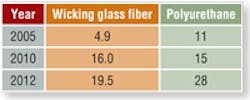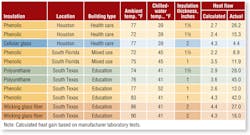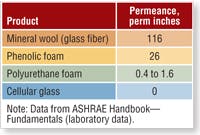Analysis: Chilled-Water-Pipe-Insulation Performance
Cellular glass, glass fiber, phenolic foam, and polyurethane foam are popular materials for insulating chilled-water pipe. As tests I recently concluded confirm, in hot, humid climates, there are significant differences in thermal performance over time between them.
I define hot, humid climates according to the ASHRAE 1-percent standard design criteria of 90°F dry bulb and 76°F or higher wet bulb. In the United States, that describes the Gulf Coast, Florida, and coastal areas from Washington, D.C., to Florida.
The insulations were tested in situ at operating commercial facilities in South Texas, South Florida, and Houston. The insulations were installed by mechanical-insulation contractors using procedures specified by the design engineers. The cellular-glass insulation was installed in 1980. The glass-fiber, phenolic-foam, and polyurethane-foam insulations were installed after 2000.
The tests were non-destructive, conducted using a thermal-imaging camera with heat-flux transducer.
The factory-furnished all-service jackets (ASJs) of the glass-fiber, phenolic-foam, and polyurethane-foam insulations were covered with mold, indicating the surface temperature of each insulation was below the ambient dew point as a result of water intrusion. Table 1 shows substantial heat gain as a result of moisture condensation within the glass-fiber and polyurethane-foam insulations.
Only the cellular-glass insulation did not absorb condensation, and only the cellular-glass-insulation facer was pristine.
Three of the four insulations gained moisture from the ambient air (Table 2). The phenolic-foam insulation gained 400 percent to 1,000 percent. The polyurethane-foam insulation gained 1,000 percent and more. The glass-fiber insulation gained 400 percent to almost 700 percent. The cellular-glass insulation did not experience moisture/thermal gain.
At the South Texas site, heat transfer increased by 400 percent through glass-fiber insulation and nearly 300 percent through polyurethane-foam insulation, increasing the cost of running the chiller system.
When it was introduced many years ago, the ASJ was a lamination of white paper, fire-resistant adhesive, glass-fiber scrim, and 1-mil (0.001 in.) aluminum foil. Since then, the aluminum foil has been reduced to 1/3 mil (0.00035 in.). It does not take much to cause tiny pinholes in the foil, which can increase the perm rate of the foil from the advertised 0.02 perm to 0.04 to 0.16 perm.
The fragile ASJ is the major factor in the thermal performance of glass-fiber, phenolic-foam, and polyurethane-foam insulations. When the ASJ is damaged or corrodes, it is only a matter of time until the insulation fills up with condensation and fails.
shows the rates at which water vapor permeates the insulations. The glass-fiber, phenolic-foam, and polyurethane-foam insulations are rather dependent on the vapor-barrier/retarder facer for thermal performance, with the polyurethane insulation lasting much longer than the glass-fiber and phenolic-foam insulations on cold pipe before filling up with water. The cellular-glass material will last indefinitely.
When the thin ASJ is compromised, it is easy to see why insulation on 45°F-plus chilled-water pipe fails. Once an ASJ is breached, a decline in thermal performance is only a matter of time. On the South Florida building, that time was just 90 days.
Note: The author wishes to thank Alan Neely for his assistance with the test data.
With more than 50 years of experience in building construction, materials technology, and design, William A. Lotz, PE, specializes in consulting on moisture and insulation problems in buildings. The author of more than 250 technical articles, he is an ASHRAE Life Member, Fellow, and Distinguished Lecturer. He is a registered professional engineer in eight states. He can be reached at 207-636-2625.



